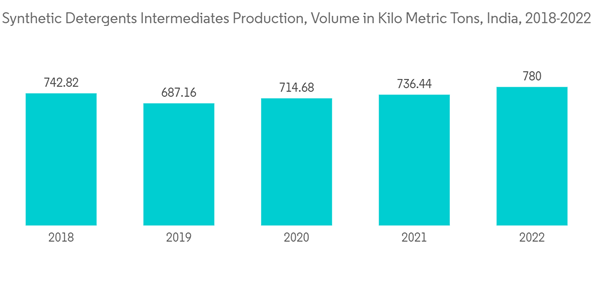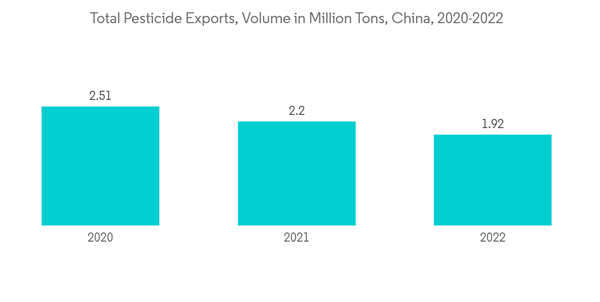The Asia-Pacific Bio-Surfactants Market size is estimated at USD 496.10 million in 2024, and is expected to reach USD 670.06 million by 2029, growing at a CAGR of 6.20% during the forecast period (2024-2029).
The market was negatively impacted by the COVID-19 outbreak in 2020. However, the pandemic has further heightened consumers’ awareness of sustainability and health thus creating demand for innovative environment-friendly products and enhancing biosurfactants' market growth.
The increasing demand for cosmetics and personal care products, and the rising usage of bio-products are the major factors driving the growth of the market studied.
However, the higher production cost of bio-surfactants stands as a restraint for the growth of the studied market.
Growing innovation in the production methods of biosurfactants will optimize the overall cost of their products which is further expected to stage lucrative growth opportunities for the growth of the market studied.
China represents the largest market over the forecast period due to the rising demand from various industries, such as personal care, pharmaceuticals, agriculture, etc. in the region.
This product will be delivered within 2 business days.
The market was negatively impacted by the COVID-19 outbreak in 2020. However, the pandemic has further heightened consumers’ awareness of sustainability and health thus creating demand for innovative environment-friendly products and enhancing biosurfactants' market growth.
The increasing demand for cosmetics and personal care products, and the rising usage of bio-products are the major factors driving the growth of the market studied.
However, the higher production cost of bio-surfactants stands as a restraint for the growth of the studied market.
Growing innovation in the production methods of biosurfactants will optimize the overall cost of their products which is further expected to stage lucrative growth opportunities for the growth of the market studied.
China represents the largest market over the forecast period due to the rising demand from various industries, such as personal care, pharmaceuticals, agriculture, etc. in the region.
Asia-Pacific Bio-Surfactants Market Trends
Detergents and Industrial Cleaners Segment is Expected to Dominate the Market
- Surfactants are the active ingredients found in soaps and detergents with the ability to concentrate at the air-water interface. They are commonly used to separate oily materials from a particular media.
- Almost all surfactants, which are an important component used in modern-day commercial laundry detergents, are chemically synthesized and exert toxicity to freshwater living organisms.
- Growing public awareness about the environmental hazards and risks associated with chemical surfactants has stimulated the search for eco-friendly and natural substitutes for chemical surfactants in laundry detergents.
- Biosurfactants, such as Cyclic Lipopeptide (CLP), are stable across a wide pH range (7.0-12.0) and do not lose their surface-dynamic properties when heated to high temperatures. They demonstrate excellent emulsion creation capability with vegetable oils, as well as outstanding resemblance and strength to commercial clothes cleaners, indicating that they should be considered in a clothing cleaners strategy.
- According to the International Trade Centre, China exports the largest amount of Soap and organic surface-active products, with exported value reaching around USD 740.98 million.
- Hindustan Unilever's Surf Excel detergent brand is the first in India's home and personal care category to reach a billion dollars in annual sales in 2022.
- Surf detergent, which was launched six decades ago, now controls more than a fifth of India's total detergent market, which is worth INR 350 billion (~USD 4.45 billion).
- According to DCP (India), during the fiscal year 2022, over 780 thousand metric tons of synthetic detergent intermediates were produced across India.
- The positive trends and high export of detergents from countries like China contribute to the increasing demand for bio-surfactants in the Asia-Pacific region during the forecast period.
China to Dominate the Market
- Bio-surfactants are considered to be less toxic and eco-friendly. Thus, several types of biosurfactants have the potential to be commercially produced for extensive applications in cosmetics, agriculture, textile, and other industries.
- According to the National Bureau of Statistics of China, the retail sales of cosmetics by wholesale and retail companies in China totaled about CNY 393.6 billion (~USD 58.53 billion) in 2022.
- In agriculture, surfactants and adjuvants are additive chemicals spray products that are added to herbicides to enhance the activities of the spray combinations.
- In 2022, China exported over 1.3 million tons of herbicides, making it the largest type of pesticide exported from China in terms of volume.
- Additionally, according to the China National Garment Association, China produced around 23.24 billion pieces of clothes in 2022.
- In the food industry, bio-surfactants can be used for the cleaning and treatment of contact surfaces, acting as antimicrobial and anti-biofilm agents. They can also be incorporated directly into formulations as an additive or ingredient.
- Therefore, the strong demand from the domestic end-user industries is expected to continue stimulating the consumption of bio-surfactants in China over the forecast period.
Asia-Pacific Bio-Surfactants Industry Overview
The Asia-Pacific Bio-Surfactants Market is consolidated, with the top five players holding a significant share of market demand in the region. The major players (not in any particular order) include BASF SE, Henkel AG & Co. KGaA, Evonik Industries AG, Clariant, and Croda International Plc, among others.Additional Benefits:
- The market estimate (ME) sheet in Excel format
- 3 months of analyst support
This product will be delivered within 2 business days.
Table of Contents
1 INTRODUCTION
4 MARKET DYNAMICS
5 MARKET SEGMENTATION (Market Size in Value)
6 COMPETITIVE LANDSCAPE
7 MARKET OPPORTUNITIES AND FUTURE TRENDS
Methodology

LOADING...










